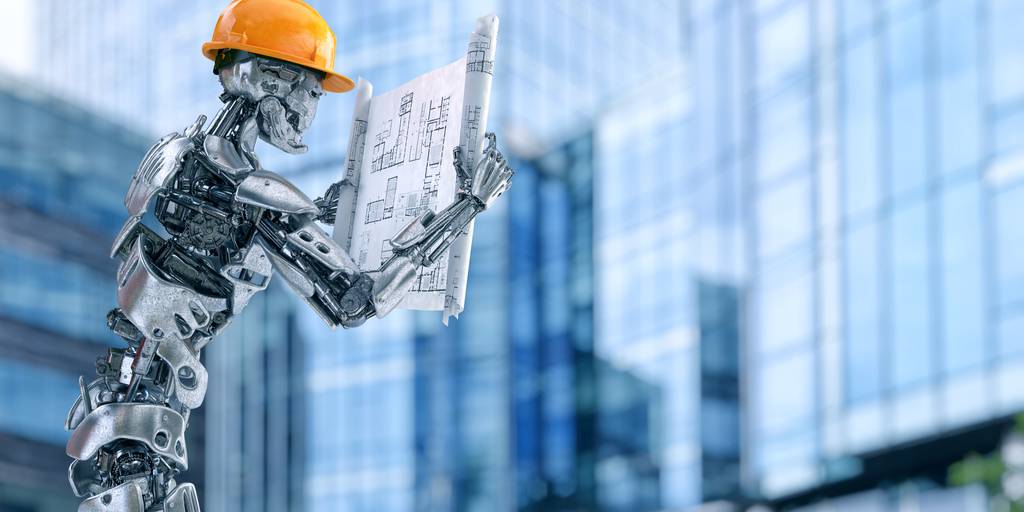Artificial intelligence is all the rage these days. We use it daily in everything from voice assistants like Siri and Alexa, Facebook’s image recognition software, Google’s search engines, and getting recommendations on what to buy from Amazon and what to watch on Netflix.
Artificial intelligence is being applied in a number of fields, including agriculture, medicine, business, marketing and advertising, customer service, and banking. So, is there a place for artificial intelligence in the construction industry? Of course there is. In fact, there are quite a few applications already in use and others in development that will benefit the construction industry in the years to come.
What is Artificial Intelligence?
When we talk about artificial intelligence, we're focusing on technology that enables computers and machines to mimic human intelligence. The ability to learn, think, and reason like humans for cognitive functions like decision-making, image recognition, speech recognition, language translation, etc.
Machine learning, a subset of artificial intelligence, is where we are likely to see the most applications of AI in the construction industry. Machine learning uses algorithms to learn from data, identify patterns, and make decisions without having to be programmed.
Artificial Intelligence in Construction
Construction projects generate reams of data from daily reports, telematics, plans and specs, punch lists, worker productivity levels, job costs, takeoffs and estimates, change orders, jobsite photos, as-builts, RFIs, and more.
The problem is that all this data is unstructured, it's collected and stored both manually and digitally on disparate systems meaning that the data is often siloed and not put to use once a project is completed. Getting all the data collected, structured, and standardized is one of the critical issues that have to be solved in order to unleash the full potential of artificial intelligence in construction.
Safer Jobsites With Artificial Intelligence
Jobsite safety is a top priority on construction projects. Unfortunately, there hasn't been much improvement made in the last decade in reducing the number of jobsite fatalities. Construction doesn't take place in a controlled environment as they do in, say, a manufacturing plant. Site conditions are constantly changing and an influx of less experienced workers only compounds the challenges of preventing accidents and protecting workers.
Technology like wearables, drones, site sensors, and exoskeletons are already being used to make jobsites safer. Another tool that will soon start popping up on jobsites is image recognition software. Smatvid.io has developed an AI engine named VINNIE, or Very Intelligent Neural Network for Insight & Evaluation. VINNIE was trained to identify construction workers in photos and videos and determine whether they are wearing proper personal protective equipment (PPE) such as hard hats and safety vests.
During ENR's annual photo contest in 2016, VINNIE was pitted against humans in a man-versus-machine competition to sort through 1,080 photos to identify safety violations. VINNIE was able to process the photos in minutes and correctly identified more violations than the team of humans who took nearly five hours to sort through the same photos.
Over time, and by reviewing more and more images, the software can get faster and more accurate. Imagine being able to deploy cameras to monitor workers that can instantly identify safety hazards or missing PPE and immediately alert the worker and safety manager via their smartphone or a wearable device so the issue can be corrected before an accident occurs.
Autonomous Construction Equipment
Just like with self-driving cars, artificial intelligence and machine learning is being used to develop autonomous construction equipment that can be used to improve safety, increase efficiency, and help compensate for the shortage of skilled labor. All of the major heavy equipment manufacturers are investing in and developing self-operating machines to perform tasks such as sitework, grading, excavation, demolition, paving, and more.
Autonomous machines use 3D mapping, sensors, cameras, and GPS to provide the real-time data needed for the AI to instruct the equipment on where to go and what to do. The whole time the equipment is operating, it is collecting data on the work being completed so the AI can continuously update the 3D map to reflect changes to the terrain and site conditions.
The equipment could also transmit telematics data to provide real-time diagnostics data from the various components of the equipment, such as speed, fuel consumption, engine temperature, etc. This real-time monitoring allows the AI to ensure that the work is being done accurately and that the equipment is operating as efficiently as possible.
Planning & Scheduling
The key to delivering construction projects on time and within budget lies in the planning and scheduling of the work. When issues arise, the schedule has to be tweaked and adjusted to compensate for any delays or rework. Creating a construction schedule takes hours and hours of work, and that only results in creating one project schedule.
Planning and scheduling is one area where AI can run laps around a human, regardless of their experience and expertise. ALICE is a scheduling assistant powered by artificial intelligence that uses Building Information Modeling data to run through hundreds of millions of schedules based on specific criteria and parameters to create an optimal construction schedule in a matter of minutes. Adjusting parameters such as the number of workers, available equipment, and building materials can be done to show how those changes would affect the cost of the project and the time needed for completion.
As construction progresses, the as-built data can be updated to adjust the schedule to compensate for issues or capitalize on opportunities that may arise throughout the project.
Future of Artificial Intelligence in Construction
The upside for artificial intelligence in construction is high. In addition to the applications listed, AI will also be used for building design optimization, risk assessment and mitigation, predictive logistics, and forecasting. This will eventually lead to safer, more efficient, and more productive construction sites.
